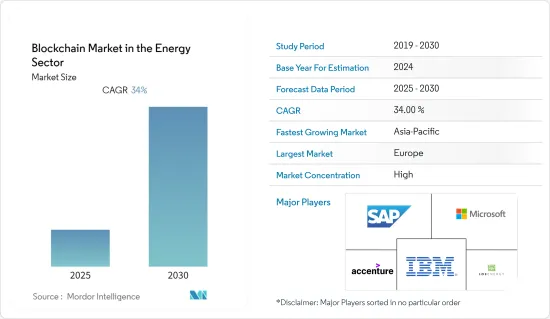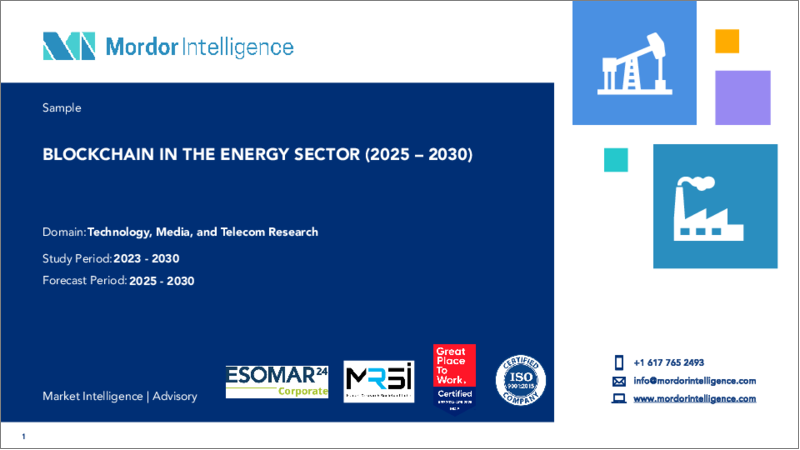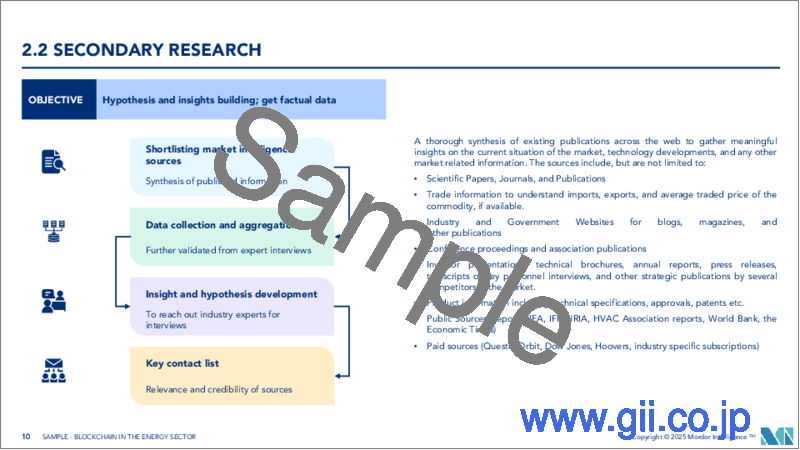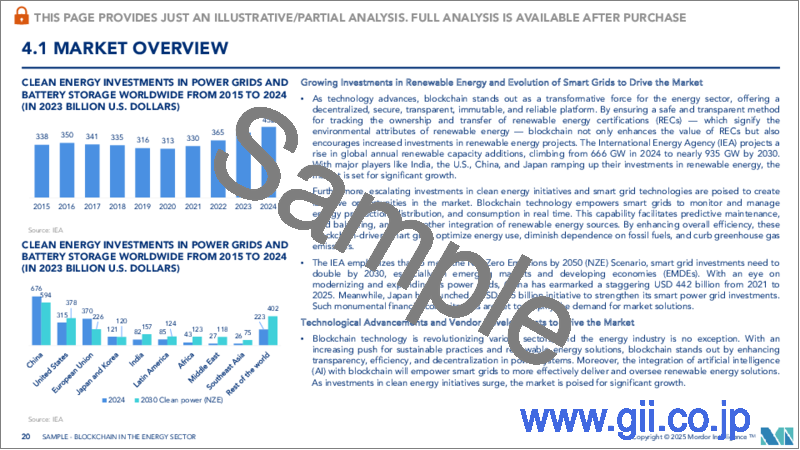|
|
市場調査レポート
商品コード
1642027
エネルギー分野におけるブロックチェーン-市場シェア分析、産業動向・統計、成長予測(2025年~2030年)Blockchain in the Energy Sector - Market Share Analysis, Industry Trends & Statistics, Growth Forecasts (2025 - 2030) |
||||||
カスタマイズ可能
適宜更新あり
|
|||||||
| エネルギー分野におけるブロックチェーン-市場シェア分析、産業動向・統計、成長予測(2025年~2030年) |
|
出版日: 2025年01月05日
発行: Mordor Intelligence
ページ情報: 英文 120 Pages
納期: 2~3営業日
|
全表示
- 概要
- 目次
エネルギー分野におけるブロックチェーン市場は予測期間中にCAGR34%を記録する見込み

主要ハイライト
- ブロックチェーン技術は、各地域が再生可能エネルギーの目標を達成し、送電網の信頼性と効率を高め、クリーンエネルギー発電にかける電力会社の負担を軽減するのに役立ちます。そのため、予測期間中にその採用が増加すると予想されます。
- マイクログリッドは、特定のエリア内で電力を取引できるほか、メイングリッドの緊急時(バックアップソリューションとして機能するなど)にもメリットがあるため、市場のベンダーはマイクログリッドの利用拡大を活用できると考えられます。その一例として、エネルギーブロックチェーンを販売するドイツのOLI Systemsが、欧州のマイクログリッドに設置したパイロットプロジェクトが挙げられます。
- エネルギー分野におけるブロックチェーンの最大のメリットは、コストの削減、環境へのダメージの軽減、プライバシーを犠牲にすることなく利害関係者間でよりオープンになることです。
- 企業向けイーサリアムソリューションのようなソフトウェアソリューションは、石油・ガスのような伝統的エネルギー分野にも役立ちます。こうした非公開ブロックチェーンネットワークを使えば、石油・ガス会社は、事前に承認された関係者だけにデータへのアクセスを許可し、選択したコンソーシアムに参加させることで、プライバシーや企業秘密を保護することができます。
- 重要な用途の中で、「決済」カテゴリはエネルギーセクターにおけるブロックチェーンの最も高い関連性と実装を示しました。分散型台帳技術は、グリッド材料の保管チェーンを追跡することで、公益事業・プロバイダーの効率を向上させる可能性があります。出所追跡だけでなく、ブロックチェーンは再生可能エネルギーの流通にも独自のソリューションを提供しています。
COVID-19のパンデミック危機は、人々、企業、経済にとって、デジタル技術とエネルギー技術を利用することの重要性を高めました。同社は、人々が在宅で仕事をし、自宅を暖め、病院を経営し、ビジネスを行う上で、デジタルとエネルギーのソリューションにどれほど依存しているかを知っていました。
エネルギー分野におけるブロックチェーンの市場動向
決済が市場で最大のシェアを占める
- ブロックチェーン台帳は、取引コストの削減、取引の効率化、エネルギーの出所の特定など、さまざまなセグメントで利用されています。例えば、IBMのBlockchain World Wireネットワークは、クロスボーダー(外国為替)決済に革命をもたらしました。ほぼリアルタイムの取引清算と最終決済を可能にしました。この方法は、当事者間で共有される合意された価値の保存庫として機能することで、決済指示メッセージを統合し、デジタル資産を活用して取引を決済します。さまざまなセグメントでの決済を強化するこのような製品の特徴は、市場での競合を生み出すと考えられます。
- ブロックチェーン技術の活用により、決済システムをスマートグリッドに接続することも可能になりました。このため、企業は金融サービスとスマートグリッド技術の融合にさらに資金を投入したいと考えるようになりました。
- ブロックチェーン技術は、従来の決済方法を有効でなくしました。また、ハッキングやデータ漏洩の問題を克服するためにも進歩しています。例えば、RWEの電力公社は、ドイツとカリフォルニアにある数百の自律走行電気自動車充電ステーションの認証と請求プロセスを管理するためにブロックチェーン技術をテストしました。
- エネルギー分野でブロックチェーンを使えば、公益企業のオーバーヘッドも最小限に抑えられます。仲介の小売業者やブローカーを介さず、電力会社と消費者の間で請求と計測のプロセスを促進することで、消費者はコスト削減の恩恵を受けることができます。
米国が大きなシェアを占める見込み
- ブロックチェーンがエネルギー産業で利用されると、エネルギー取引のような取引は約即時に記録され、決済されます。すべての関係者が同じプラットフォームを利用するため、仲介者は不要で、照合もほとんど必要ないです。技術のアーリーアダプターである北米では、エネルギー分野でブロックチェーンが多く利用されています。
- 米国エネルギー情報局によると、米国の実用規模の発電施設は2021年に約4兆1,200億キロワット時(kWh)、つまり約41億1,600万kWhのエネルギーを生み出しました。石炭、天然ガス、石油、その他のガスが発電に使われた燃料の約61%を占めました。原子力は全体の約19%を占め、再生可能エネルギーは約20%でした。小規模な太陽光発電システムによる発電量は、さらに490億kWhでした。このような大規模なエネルギー生産によって、エネルギー分野におけるブロックチェーンソリューションを導入し、決済取引やリスク・コンプライアンス管理、その他多くの問題を容易にすることが可能になります。
- 政府機関は、エネルギーグリッドの安全性を確保するためにブロックチェーンを組み込むための資金を供与しています。例えば、米国エネルギー省(DOE)は、国の電力系統の安全確保を支援するため、TFA Labsに約20万米ドルの資金を供与しています。提案された戦略では、マルウェアのない送電網上のデバイスを検証して保護すること、一般的に使用される民生用電子機器製品のセキュリティを高める技術を開発すること、ブロックチェーン技術を使用して箱から出してすぐにあらゆるアイテムを保護できる合理的な価格の方法を提供することが求められています。
- 世界中でクリーンエネルギーソリューションの構築、所有、運営を行う株式非公開会社InvenergyとGE Renewable Energyは、998メガワットのトラバース風力発電センターが2022年3月に商業運転を開始すると発表しました。これは北米で初めて単一フェーズで建設された風力発電所です。このような要因が、予測期間中の市場の成長を増大させると予想されます。
2022年1月、BMWはEnergy Webと提携し、再生可能エネルギーで電気自動車を充電するためのブロックチェーンソリューションを実証しました。充電コストはEnergy Webのブロックチェーンソリューションを通じてルーティングされました。
エネルギー分野におけるブロックチェーン産業概要
エネルギー分野におけるブロックチェーン市場には多くの大手企業が参入しており、競争は激しいです。市場シェアを見る限り、SAP SE(SAP)、Microsoft Corp.、Accenture PLC、IBM Corp.が現在の市場における3大参入企業です。これらの大手企業は市場で大きなシェアを持っているため、他国でより多くの顧客を獲得することに注力しています。これらの企業は、市場シェアと収益性を高めるために、戦略的協業イニシアティブを活用しています。製品力を強化するため、市場で事業を展開する企業は、エネルギー技術におけるブロックチェーンに取り組む新興企業の買収も進めています。
2022年7月、INFINITYはブロックチェーン企業のYesportsと提携しました。この提携は、非代替性トークン(NFT)によるファン参加型プログラムの立ち上げを目指したものです。この取引は、ファンとのエンゲージメント戦略を確立するためにブロックチェーンとWeb3に頼ろうとするeSports組織の増加を浮き彫りにしました。
Intelは2022年4月、IntelのブロックチェーンASIC(特定用途向け集積回路)を発表しました。このチップは、プルーフ・オブ・ワーク・コンセンサス・ネットワークのハッシュをよりエネルギー効率的にするものとされています。
その他の特典
- エクセル形式の市場予測(ME)シート
- 3ヶ月間のアナリストサポート
目次
第1章 イントロダクション
- 調査の前提条件と市場定義
- 調査範囲
第2章 調査手法
第3章 エグゼクティブサマリー
第4章 市場洞察
- 市場概要
- 産業の魅力-ポーターのファイブフォース分析
- 供給企業の交渉力
- 消費者の交渉力
- 新規参入業者の脅威
- 競争企業間の敵対関係
- 代替品の脅威
- 産業バリューチェーン分析
- COVID-19の市場への影響評価
- 市場促進要因
- 変動電気料金の出現とピアツーピア取引の必要性
- ベンチャーキャピタルによる積極的な投資
- 市場抑制要因
- スケーラビリティの制約
- エネルギー分野におけるブロックチェーン-地域による使用事例シナリオ
第5章 市場セグメンテーション
- 用途別
- ペイメント
- スマートコントラクト
- デジタルID確認
- ガバナンス、リスク、コンプライアンス管理
- その他
- 地域別
- 北米
- 米国
- カナダ
- 欧州
- 英国
- ドイツ
- オランダ
- その他の欧州
- アジア太平洋
- 日本
- オーストラリア
- ニュージーランド
- その他のアジア太平洋
- ラテンアメリカ
- ブラジル
- メキシコ
- その他のラテンアメリカ
- 中東・アフリカ
- アラブ首長国連邦
- イスラエル
- その他の中東・アフリカ
- 北米
第6章 競合情勢
- 企業プロファイル
- SAP SE(SAP)
- Electron(Chaddenwych Services Limited)
- Accenture PLC
- IBM Corporation
- LO3 Energy Inc.
- GREENEUM
- Drift Marketplace Inc.
- IOTA Foundation
- Btl Group Ltd.
- Power Ledger Pty Ltd.
- ImpactPPA
第7章 投資分析
第8章 将来の機会
The Blockchain Market in the Energy is expected to register a CAGR of 34% during the forecast period.

Key Highlights
- Blockchain technology helps regions meet their goals for renewable energy, makes grids more reliable and efficient, and cuts down on the amount of money utilities have to spend on clean energy generation. Thus, its adoption is expected to increase over the forecast period.
- Since microgrids allow electricity to be traded within a certain area and have other benefits during emergencies with the main grid (like acting as backup solutions), vendors on the market could take advantage of the growing use of microgrids. One illustration is the pilot project that German company OLI Systems, which sells energy blockchains, set up in Europe's microgrid.
- The biggest benefits of blockchain in the energy sector are lower costs, less damage to the environment, and more openness among stakeholders without sacrificing privacy.
- Software solutions, such as enterprise Ethereum solutions, can also help traditional energy sectors like oil and gas. With these private blockchain networks, oil and gas companies can protect their privacy and trade secrets by giving only pre-approved parties access to their data and letting them join select consortiums.
- Among significant applications, the 'payments' category exhibited the highest association and implementation of blockchain in the energy sector. By tracking the chain of custody for grid materials, distributed ledger technology can potentially improve utility providers' efficiencies. Beyond provenance tracking, blockchain offers unique solutions for renewable energy distribution.
The COVID-19 pandemic crisis made it more important for people, businesses, and the economy to use digital and energy technologies. The company knew how much it depended on digital and energy solutions to help people work from home, heat their homes, run hospitals, and run their businesses.
Blockchain in Energy Sector Market Trends
Payments Hold the Largest Share in the Market
- The blockchain ledger is used in many different fields to lower transaction costs, make exchanges more efficient, and find out where energy comes from. For instance, IBM's Blockchain World Wire network revolutionized cross-border (Forex) payments. It enabled nearly real-time transaction clearing and settlement with finality. By acting as an agreed-upon store of value shared between parties, the method integrated payment instruction messages and leveraged digital assets to settle transactions. Such product features that enhance payments in different sectors will create a competitive edge in the market.
- The use of blockchain technology also made it possible to connect payment systems to smart grids. This made the companies want to put even more money into combining financial services with smart grid technology.
- Blockchain technology has made traditional payment methods less effective. It is also advancing to overcome the issues of hacking and data breaches. For instance, RWE's power utility has tested blockchain technology to authenticate and manage the billing process for hundreds of autonomous electric vehicle charging stations in Germany and California.
- Using blockchain in the energy sector would also minimize the overhead for utilities. By facilitating the billing and metering process between the utility and the consumer instead of involving intermediary retailers and brokers, consumers benefit from lower costs.
United States is Expected to Hold Major Share
- When blockchain is used in the energy industry, transactions, like trading energy, can be recorded and settled almost immediately. Since all parties use the same platform, there is no need for an intermediary and little need for reconciliation. As early adopters of technology, North Americans are seeing a lot of blockchain being used in the energy sector.
- According to the US Energy Information Administration, utility-scale electricity-producing facilities in the US generated nearly 4.12 trillion kilowatt-hours (kWh), or about 4.116 billion kWh, of energy in 2021. Coal, natural gas, petroleum, and other gases made up about 61% of the fuel used to generate this power. Nuclear energy roughly accounted for 19% of the total, while renewable energy sources comprised about 20%. Small-scale solar photovoltaic systems generated an additional 49 billion kWh of electricity. Such massive energy production will enable the energy sector to adopt blockchain solutions to ease payment transactions, risk and compliance management, and many other issues.
- Government bodies are granting funds to incorporate blockchain to secure energy grids. For example, to assist in safeguarding the national power system, the US Department of Energy (DOE) is awarding TFA Labs almost USD 200,000 in funding. The suggested strategy calls for verifying and securing devices on the grid that are free of malware, creating technology to increase the security of commonly used consumer electronics, and offering a reasonably priced way to secure any item right out of the box using blockchain technology.
- Invenergy, a privately held company that builds, owns, and runs clean energy solutions around the world, and GE Renewable Energy announced that the 998-megawatt Traverse Wind Energy Center will begin commercial operations in March 2022. This was the first wind farm in North America to be built in a single phase. Such factors are expected to augment the market's growth during the forecast period.
In January 2022, BMW partnered with Energy Web to demonstrate a blockchain solution for recharging electric vehicles with renewable energy. The charging cost was routed through Energy Web's blockchain solution.
Blockchain in Energy Sector Industry Overview
There are a lot of big players in the energy blockchain market, which is very competitive. As far as market share goes, SAP SE (SAP), Microsoft Corp., Accenture PLC, and IBM Corp. are the three biggest players on the market right now. These big players have a big share of the market, so they are focusing on getting more customers in other countries. These companies leverage strategic collaborative initiatives to increase their market shares and profitability. To strengthen their product capabilities, the companies operating in the market are also acquiring start-ups working on blockchain in energy technologies.
In July 2022, INFINITY partnered with the blockchain company Yesports. This partnership aimed to launch a fan engagement program based on non-fungible tokens (NFTs). The deal highlighted an increasing number of esports organizations looking to rely on blockchain and Web3 to establish fan engagement strategies.
Intel announced in April 2022 that their new Intel Blockchain ASIC (application-specific integrated circuit) was coming out. This chip is supposed to make hashing for proof-of-work consensus networks more energy-efficient.
Additional Benefits:
- The market estimate (ME) sheet in Excel format
- 3 months of analyst support
TABLE OF CONTENTS
1 INTRODUCTION
- 1.1 Study Assumptions And Market Definition
- 1.2 Scope Of The Study
2 RESEARCH METHODOLOGY
3 EXECUTIVE SUMMARY
4 MARKET INSIGHTS
- 4.1 Market Overview
- 4.2 Industry Attractiveness - Porter's Five Forces Analysis
- 4.2.1 Bargaining Power of Suppliers
- 4.2.2 Bargaining Power of Consumers
- 4.2.3 Threat of New Entrants
- 4.2.4 Intensity of Competitive Rivalry
- 4.2.5 Threat of Substitutes
- 4.3 Industry Value Chain Analysis
- 4.4 Assessment Of The Impact Of COVID-19 On The Market
- 4.5 Market Drivers
- 4.5.1 Emergence of Variable Electricity Rates and Need for Peer-to-peer Trading
- 4.5.2 Aggressive Spending by Venture Capitalists
- 4.6 Market Restraints
- 4.6.1 Scalability Constraints
- 4.7 Blockchain In Energy Sector - Use Case Scenario Across The Region
5 MARKET SEGMENTATION
- 5.1 By Application
- 5.1.1 Payments
- 5.1.2 Smart Contracts
- 5.1.3 Digital Identities
- 5.1.4 Governance, Risk, and Compliance Management
- 5.1.5 Other Applications
- 5.2 By Geography
- 5.2.1 North America
- 5.2.1.1 United States
- 5.2.1.2 Canada
- 5.2.2 Europe
- 5.2.2.1 United Kingdom
- 5.2.2.2 Germany
- 5.2.2.3 Netherlands
- 5.2.2.4 Rest of Europe
- 5.2.3 Asia-Pacific
- 5.2.3.1 Japan
- 5.2.3.2 Australia
- 5.2.3.3 New Zealand
- 5.2.3.4 Rest of Asia-Pacific
- 5.2.4 Latin America
- 5.2.4.1 Brazil
- 5.2.4.2 Mexico
- 5.2.4.3 Rest of Latin America
- 5.2.5 Middle East and Africa
- 5.2.5.1 United Arab Emirates
- 5.2.5.2 Israel
- 5.2.5.3 Rest of Middle East and Africa
- 5.2.1 North America
6 COMPETITIVE LANDSCAPE
- 6.1 Company Profiles
- 6.1.1 SAP SE (SAP)
- 6.1.2 Electron (Chaddenwych Services Limited)
- 6.1.3 Accenture PLC
- 6.1.4 IBM Corporation
- 6.1.5 LO3 Energy Inc.
- 6.1.6 GREENEUM
- 6.1.7 Drift Marketplace Inc.
- 6.1.8 IOTA Foundation
- 6.1.9 Btl Group Ltd.
- 6.1.10 Power Ledger Pty Ltd.
- 6.1.11 ImpactPPA






